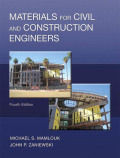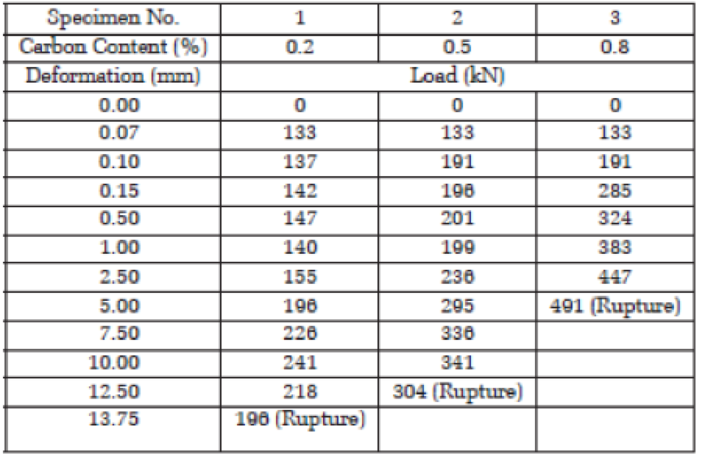
EBK MATERIALS FOR CIVIL AND CONSTRUCTIO
4th Edition
ISBN: 8220102719569
Author: ZANIEWSKI
Publisher: PEARSON
expand_more
expand_more
format_list_bulleted
Textbook Question
Chapter 3, Problem 3.19QP
Three steel bars with a diameter of 25 mm and carbon contents of 0.2, 0.5, and 0.8%, respectively. The specimens were subjected to tension until rupture. The load versus deformation results were as shown in Table P3.19.
If the gauge length is 50 mm, determine the following:
- a. a The tensile stresses and strains for each specimen at each load increment.
- b. b Plot stresses versus strains for all specimens on one graph.
TABLE P3.19

- c. The proportional limit for each specimen.
- d. The 0.2% offset yield strength for each specimen.
- e. The modulus of elasticity for each specimen.
- f. The strain at rupture for each specimen.
- g. Comment on the effect of increasing the carbon content on the following:
- i. Yield strength
- ii. Modulus of elasticity
- iii. Ductility
Expert Solution & Answer
Want to see the full answer?
Check out a sample textbook solution
Students have asked these similar questions
Please solve manually and follow all rules for flow net construction. Provide a scale such that the flow net produced can be copied.
Please solve manually, and give any tips on how I can manually recreate the flow net you provide. Thanks.
A group of nine piles. 12m long and 350 mm in
diameter, is to be arrenged in a square form in
clay soil with an average unconfined
compressive strength of 60 KN/m^2. Work out
center to center spacing of the piles for a group
effeciency factor of 1, Neglect bearing at the tip
of the piles.
Chapter 3 Solutions
EBK MATERIALS FOR CIVIL AND CONSTRUCTIO
Ch. 3 - What is the chemical composition of steel? What is...Ch. 3 - Why does the ironcarbon phase diagram go only to...Ch. 3 - Draw a simple ironcarbon phase diagram showing the...Ch. 3 - What is the typical maximum percent of carbon in...Ch. 3 - Calculate the amounts and compositions of phases...Ch. 3 - Briefly discuss four heat treatment methods to...Ch. 3 - Define alloy steels. Explain why alloys are added...Ch. 3 - Prob. 3.8QPCh. 3 - Specifically state the shape and size of the...Ch. 3 - What are the typical uses of structural steel?
Ch. 3 - What is the range of thicknesses of cold-formed...Ch. 3 - Why is coil steel used for cold-formed steel...Ch. 3 - If a steel with a 33 ksi yield strength is used...Ch. 3 - Why is reinforcing steel used in concrete? Discuss...Ch. 3 - What is high-performance steel? State two HPS...Ch. 3 - Name three mechanical tests used to measure...Ch. 3 - The following laboratory tests are performed on...Ch. 3 - Sketch the stress-strain behavior of steel, and...Ch. 3 - Three steel bars with a diameter of 25 mm and...Ch. 3 - Three steel bars with a diameter of 0.5 in. and...Ch. 3 - Draw a typical stressstrain relationship for steel...Ch. 3 - Getting measurements from Figure 3.18, determine...Ch. 3 - A steel specimen is tested in tension. The...Ch. 3 - A steel specimen is tested in tension. The...Ch. 3 - A No. 10 steel rebar is tested in tension. By...Ch. 3 - A mild steel specimen originally 300 mm long is...Ch. 3 - A tension stress of 70 ksi was applied on a 12-in....Ch. 3 - A tensile stress is applied along the long axis of...Ch. 3 - A cylindrical steel alloy rod with a 0.5 in....Ch. 3 - A round steel alloy bar with a diameter of 0.75...Ch. 3 - A 19-mm reinforcing steel bar and a gauge length...Ch. 3 - Testing a round steel alloy bar with a diameter of...Ch. 3 - During the tension test on a steel rod within the...Ch. 3 - A grade 36 round steel bar with a diameter of 0.5...Ch. 3 - A high-yield-strength alloy steel bar with a...Ch. 3 - Estimate the cross-sectional area of a 350S125-27...Ch. 3 - An ASTM A615 grade 60 number 10 rebar with a gauge...Ch. 3 - A 32-mm rebar with a gauge length of 200 mm was...Ch. 3 - A steel pipe having a length of 3 ft. an outside...Ch. 3 - A steel pipe having a length of 1 m, an outside...Ch. 3 - A drill rod with a diameter of 10 mm is made of...Ch. 3 - A drill rod with, a diameter of 1/2 in. is made of...Ch. 3 - Prob. 3.43QPCh. 3 - An engineering technician performed a tension test...Ch. 3 - A Charpy V Notch (CVN) test was performed on a...Ch. 3 - Prob. 3.46QPCh. 3 - Prob. 3.47QPCh. 3 - How can the flaws in steel and welds be detected?...Ch. 3 - Determine the welding zone classification of A36...Ch. 3 - Briefly define steel corrosion. What are the four...Ch. 3 - Discuss the main methods used to protect steel...
Additional Engineering Textbook Solutions
Find more solutions based on key concepts
Comprehension Check 7-14
The power absorbed by a resistor can be given by P = I2R, where P is power in units of...
Thinking Like an Engineer: An Active Learning Approach (4th Edition)
How does a computers main memory differ from its auxiliary memory?
Java: An Introduction to Problem Solving and Programming (8th Edition)
This optional Google account security feature sends you a message with a code that you must enter, in addition ...
SURVEY OF OPERATING SYSTEMS
What is an uninitialized variable?
Starting Out with Programming Logic and Design (5th Edition) (What's New in Computer Science)
1.2 Explain the difference between geodetic and plane
surveys,
Elementary Surveying: An Introduction To Geomatics (15th Edition)
How is the hydrodynamic entry length defined for flow in a pipe? Is the entry length longer in laminar or turbu...
Fluid Mechanics: Fundamentals and Applications
Knowledge Booster
Learn more about
Need a deep-dive on the concept behind this application? Look no further. Learn more about this topic, civil-engineering and related others by exploring similar questions and additional content below.Similar questions
- SOLVE BY NEWTON - RAPHSON METHOD: The equation x³-3x-4=0 is of the form f(x) = 0 where f(1) 0 so there is a solution to the equation between 1 and 3. We shall take this to be 2, by bisection. Find a better approximation to the root.arrow_forwardKindly help to provide answers, elaborate with examples and provide useful links for learning purposes. this is regarding building diagnosis.arrow_forwardpounds of steel need to be purchased for the roof plan a table with various steel types and the quantity needed The colums are 18 feet high and weigh 76 ponds per foot include a structural steel material list for the roof framing planarrow_forward
- Homework: Determine the proportions of the separate aggregates that will give a gradation within the SCRB wearing coarse specified limits for the aggregates and mix composition for highway pavement asphaltic concrete. The table below shows the results of sieve analysis of samples from the materials available. برو Percent by Weight Passing Sieve Designation Retained on Sieve Designation Coarse Aggregate Fine Aggregate Mineral Filler 3/4 in. (19 mm) 1/2 in. 5 ½ in. (12.5 mm) 3/8 in. 35 ¾ in. (9.5 mm) No. 4 38 No. 4 (4.75 mm) No. 10 17 No. 10 (2 mm) No. 40 5 No. 40 (0.425 mm) No. 80 No. 80 (0.180 mm) No. 200 No. 200 (0.075 mm) Total 18 1118 30 35 5 26 35 60 100 100 100arrow_forwardFor the driven pile shown in figure, estimate the allowable capacity by: (a) Tomlinson a-method, (b)Vijayvergia and Focht A-method. Which one of the two methods are more conservative? Qall =? W.T 18.21 kN/m² 930 L=18m Square pile 27.5cm x 27.5cmarrow_forwardWhat is the vertical deflection at joint C of the truss shown? 75 kN 9 m 7 (3000 mm²) (3000 mm²) (2000 mm²) (3000 mm²) (2000 mm²) 100 kN (3000 mm²) H (3000 mm²) (2000 mm²) (2000 mm²) (3000 mm²)B(3000 mm²) C(3000 mm²)D(3000 mm2)5 a. 9.3 mm↓ b. 9.6 mm↓ c. 8.0 mm ↓ d. 9.1 mm↓ 4 at 6 m = 24 m E = 200 GPa Earrow_forward
- INVERSE FROM POINT A TOWARDS POINT B GIVEN THE FOLLOWINGCOORDINATE VALUES: POINT AN=13,163,953.37'E=3,072,227.10' POINT BN=13,163,463.03'E=3,072,129.30' FIND THE FOLLOWING:DISTANCE FROM A TO BNORTH AZIMUTH (NAZ) FROM A TOWARDS BBEARING OF THE LINE FROM A TOWARDS Barrow_forwardFORWARD FROM POINT B TO POINT A GIVEN THE FOLLOWING: POINT BN=13,163,463.03'E=3,072,129.30' DIRECTION FROM B TO A (NAZ)=276.07529° DISTANCE FROM B TO A = 10.00'arrow_forwardA cheetah is crouched 20 m to the east of an observer. At time t = 0 s, the cheetah begins to run due east toward an antelope that is 50 m to the east of the observer. During the first 2.0 s of the attack, the cheetah's coordinate x varies with time according to the equation x = 20 + 5t?. (a) Find the cheetah's displacement between t1 = 1.0 s and t2 = 2.0 s. (b) Find its average velocity during that interval. (c) Derive an expression for the cheetah's instantaneous velocity as a function of time, and use it to find Vy at t = 1.0 s and t = 2.0 s.arrow_forward
- Write at least 20 words for vocabulary and 10 verbs .for simple present, past, and past participlesarrow_forwardCan you compute the Panel Board Management while using the Lighting and Power Layout Plan as the base for it? The attached Panel Board Management picture is just an example. ps. not graded, I just want to know how to compute it based on a planarrow_forwardMake Sure the attached pic is correct, because the answer in mannings equation is wrong. Can you design a (Open Channel): -Most Efficient Section (Rectangular Shape) -Cost Estimate -Structural Analysis Design Requirements: Bed Slope= 1:1500 Manning's (n)= 0.015 Discharge: Q= 18 m^3/sarrow_forward
arrow_back_ios
SEE MORE QUESTIONS
arrow_forward_ios
Recommended textbooks for you
 Steel Design (Activate Learning with these NEW ti...Civil EngineeringISBN:9781337094740Author:Segui, William T.Publisher:Cengage Learning
Steel Design (Activate Learning with these NEW ti...Civil EngineeringISBN:9781337094740Author:Segui, William T.Publisher:Cengage Learning Materials Science And Engineering PropertiesCivil EngineeringISBN:9781111988609Author:Charles GilmorePublisher:Cengage Learning
Materials Science And Engineering PropertiesCivil EngineeringISBN:9781111988609Author:Charles GilmorePublisher:Cengage Learning Construction Materials, Methods and Techniques (M...Civil EngineeringISBN:9781305086272Author:William P. Spence, Eva KultermannPublisher:Cengage Learning
Construction Materials, Methods and Techniques (M...Civil EngineeringISBN:9781305086272Author:William P. Spence, Eva KultermannPublisher:Cengage Learning Principles of Foundation Engineering (MindTap Cou...Civil EngineeringISBN:9781337705028Author:Braja M. Das, Nagaratnam SivakuganPublisher:Cengage Learning
Principles of Foundation Engineering (MindTap Cou...Civil EngineeringISBN:9781337705028Author:Braja M. Das, Nagaratnam SivakuganPublisher:Cengage Learning

Steel Design (Activate Learning with these NEW ti...
Civil Engineering
ISBN:9781337094740
Author:Segui, William T.
Publisher:Cengage Learning

Materials Science And Engineering Properties
Civil Engineering
ISBN:9781111988609
Author:Charles Gilmore
Publisher:Cengage Learning

Construction Materials, Methods and Techniques (M...
Civil Engineering
ISBN:9781305086272
Author:William P. Spence, Eva Kultermann
Publisher:Cengage Learning

Principles of Foundation Engineering (MindTap Cou...
Civil Engineering
ISBN:9781337705028
Author:Braja M. Das, Nagaratnam Sivakugan
Publisher:Cengage Learning
Material Properties 101; Author: Real Engineering;https://www.youtube.com/watch?v=BHZALtqAjeM;License: Standard YouTube License, CC-BY